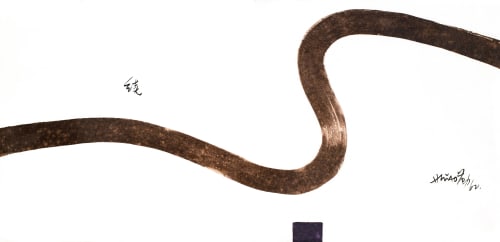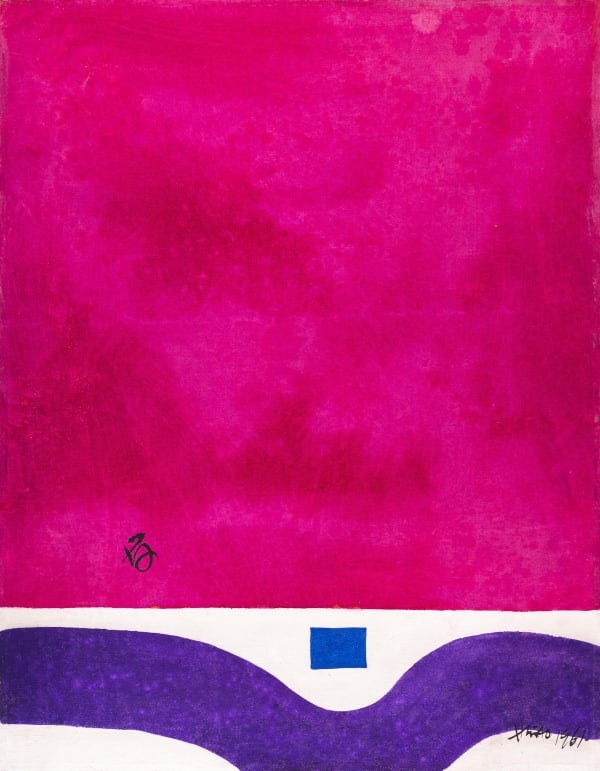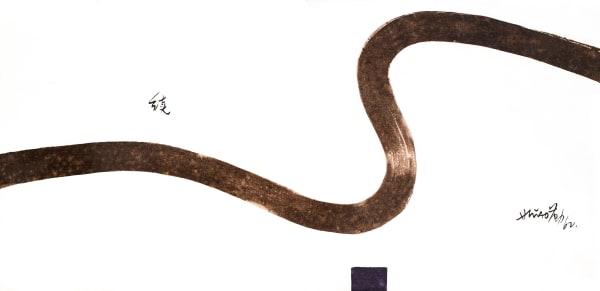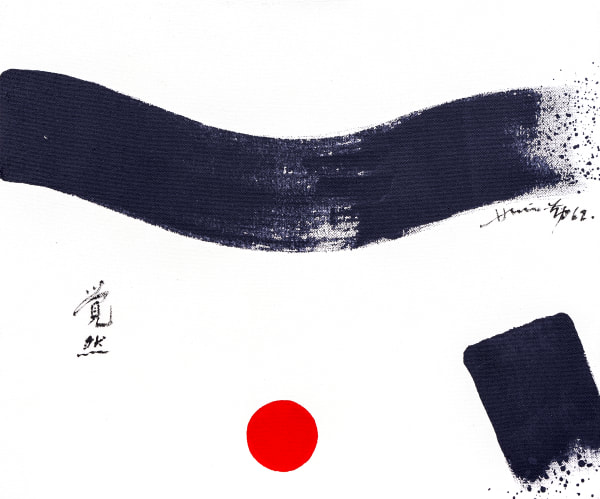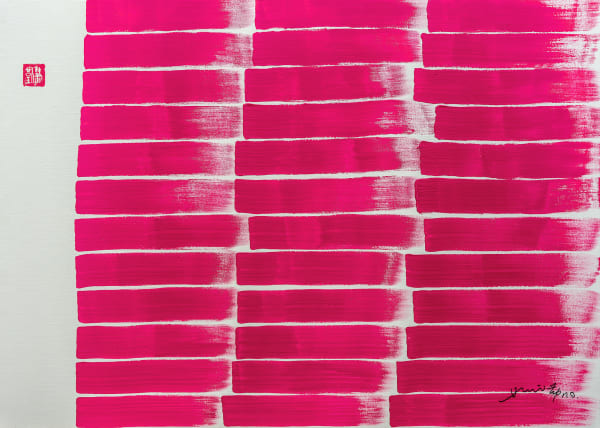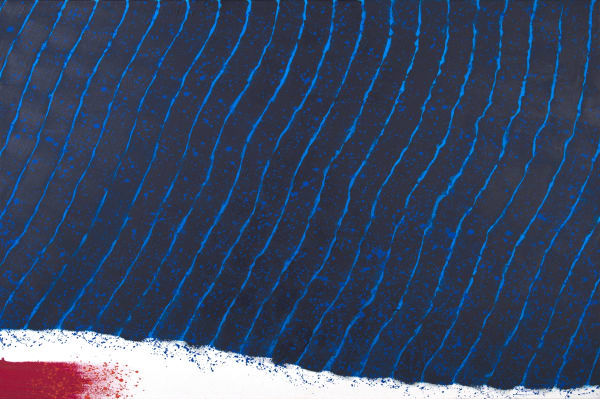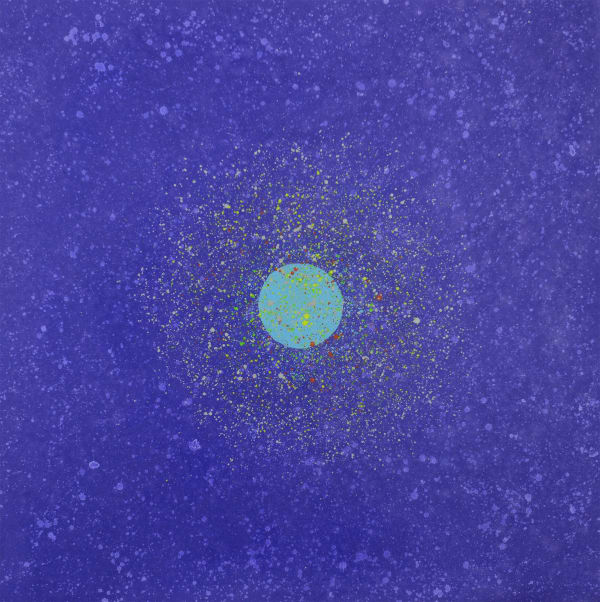Hsiao Chin and Punto
In the postwar global artworld, Hsiao Chin’s achievements are both singular and remarkable. He helped to shape the agendas of both European and Asian art; was a member of the first Chinese art group with an abstract art agenda; the artist who introduced Tapies to Buddhism; an artist whose work has been collected by both western and Asian museums– and the only Chinese artist to be co-founder of a European art movement, the influential Punto Movement that flourished in Milan from 1961 to 1966. This exhibition is devoted largely to the works in the Punto years and after.
As western museums and galleries begin to examine the influence of eastern aesthetics on western art, Hsiao Chin’s Punto movement which he founded with the Italian artist Antonio Calderera and the Japanese artist Azuma Kenjiro begins to be recognized as a key European art movement connecting ‘east’ and ‘west’ – one that made introspection and meditation its guiding principles, drawing on the work of Lao Tse and other Chinese philosophers. Advocates of Punto included Lucio Fontana, whose reputation helped popularise the movement, as well as artists associated with the Zero Group and Op Art. As Philip Dodd, the curator and former Director of London’s ICA has said,
‘As an interest in spirituality and art surfaces again, Hsiao Chin's practice feels exemplary and his mix of European and Asian art profoundly timely.’
Hsiao Chin’s Punto Spirit
Punto, in Italian means 'point' or ‘dot’ which implicitly gestures towards Eastern philosophy from which all things are in one. From the circle, Hsiao Chin has developed his cosmology and philosophy of life through his art. In Artist as Astronaut, a major retrospective exhibition held in Song Art Museum, Beijing in 2021, Hsiao said,
“My decades of research and experience in Eastern and Western art, philosophy, religion, mysticism and space civilization have formed a foundation for my interpretation of the essence of the universe and the cyclical evolution of life forces. The broad nourishment to be found within these great ideas is the source of my creative inspiration, regardless of the creative themes or titles.My artworks place a greater emphasis on the cosmic unity connected to human spiritual life, and the sentient energy that resides deep within all tangible and intangible life, forms of matter, cultures and religions, driving their motion and coexistence.That is why I call myself an astronaut, a man of the universe.”
Hsiao Chin organised thirteen Punto exhibitions across Europe and Asia from 1961 to 1966, bringing together twenty-six artists from eleven countries, making Punto one of the first large scale collaborations uniting artists from the East and West.
Born in Shanghai in 1935, Hsiao Chin was one of a number of Chinese artists who settled in Europe in the 1950s - others include Zao Wou-ki, whose impact on French modern art was analogous to Hsiao Chin’s on Italian art. In 1964, Hsiao Chin became the first Chinese artist after Zao Wou-ki, to have a solo exhibition in Paris, presented by the eminent Galerie Internationale d'Art Contemporain, which represented him from 1963-1966. During the 60s and early 70s, he travelled extensively in Europe and the United states, In the latter, he met, among others, Willem De Kooning, Robert Rauschenberg, Sam Francis and Mark Rothko.
Hsiao Chin is a visionary Chinese artist whose entire life and work is a testament to his openness to the world and its cultures, and especially to the exchange between cultures. His works can be found in international collections, including Museum of Modern Art (MoMA, USA), Philadelphia Museum of Art (USA), Shanghai Art Museum (China) Galleria Nazionale d'Arte Moderna (Italy), Staatsgalerie Stuttgart (Germany) and M+ Museum (Hong Kong).
The First Return to the U.K. since 1966
Hsiao Chin and Punto at 3812 Gallery London is the artist’s first solo exhibition in the U.K since his solo at Signals Gallery, London in 1966. Produced with the support of the Hsiao Chin Art Foundation, this exhibition presents the iconic works that have been widely presented in exhibitions or retrospectives in major museums in recent years, including Musée national des arts asiatiques Guimet, Paris, Mark Rothko Art Centre, Latvia in 2020, and Song Art Museum, Beijing in 2021. Highlights of the exhibition include a collection of rare works from the Punto period such as La Forza (1962), Silencio (1962), The Awakening (1962), Beginning of Tao (1962), Power of the Light (1965) and Inner Light (1966).
Calvin Hui, the exhibition curator and Co-founder of 3812 Gallery says,
“When I take in Hsiao Chin's paintings and consider his journey in life, my heart opens to the vivid and chromatic effects of his works in the West. Hsiao Chin viscerally inhabits Eastern aesthetics and religious philosophy and offers them to the world, and then brings back a powerful spiritual strength to his homeland".

Hsiao Chin in his studio, 1962
Philip Dodd once commented,
‘A Chinese artist at the heart of the 60s European avant-garde: Hsiao Chin's career and his wildly inventive paintings challenge most categories. His peers may appear to be the Italian Lucio Fontana and the American Kenneth Noland - but in his search for a language of painting that can incarnate spiritual experiences, the only comparable painter of the time is Mark Rothko - which makes holding Hsiao Chin's retrospective in Mark Rothko's hometown museum so compelling.’
Akin to a circle, Hsiao’s journey epitomises an eternal process of departing and returning to the original point.
Hsiao Chin and Punto kicks off a year-long international programme to celebrate the artist’s lifelong achievement. It includes a dedicated display at 3812 gallery’s stand (Stand 617) at Masterpiece London 2022 (30 June - 6 July).
Calvin Hui - Co-founder and Curator
A monograph, Mapping Post-War Avant-Garde: Hsiao Chin and Punto International by Dr. Joshua Gong was published by Unicorn Publishing in June 2020.
-
 Hsiao Chin 蕭勤, Painting - BA《繪畫 - BA》, 1959
Hsiao Chin 蕭勤, Painting - BA《繪畫 - BA》, 1959 -
 Hsiao Chin 蕭勤, Pittura-CB《繪畫-CB》, 1959
Hsiao Chin 蕭勤, Pittura-CB《繪畫-CB》, 1959 -
 Hsiao Chin 蕭勤, Retain《存》, 1961
Hsiao Chin 蕭勤, Retain《存》, 1961 -
 Hsiao Chin 蕭勤, Continuity《續》, 1962
Hsiao Chin 蕭勤, Continuity《續》, 1962 -
 Hsiao Chin 蕭勤, La Forza《勁》, 1962
Hsiao Chin 蕭勤, La Forza《勁》, 1962 -
 Hsiao Chin 蕭勤, Il silenzio《靜》, 1962
Hsiao Chin 蕭勤, Il silenzio《靜》, 1962 -
 Hsiao Chin 蕭勤, The Beginning of Tao-2《道之始-2》, 1962
Hsiao Chin 蕭勤, The Beginning of Tao-2《道之始-2》, 1962 -
 Hsiao Chin 蕭勤, The Beginning of Tao-6《道之始-6》, 1962
Hsiao Chin 蕭勤, The Beginning of Tao-6《道之始-6》, 1962 -
 Hsiao Chin 蕭勤, The Awakening《覺然》, 1962
Hsiao Chin 蕭勤, The Awakening《覺然》, 1962 -
 Hsiao Chin 蕭勤, Origin-1《緣起-1》, 1964
Hsiao Chin 蕭勤, Origin-1《緣起-1》, 1964 -
 Hsiao Chin 蕭勤, Origin-2《緣起-2》, 1965
Hsiao Chin 蕭勤, Origin-2《緣起-2》, 1965 -
 Hsiao Chin 蕭勤, Power of the Light《光之力》, 1965
Hsiao Chin 蕭勤, Power of the Light《光之力》, 1965 -
 Hsiao Chin 蕭勤, Inner Light《內在的光》, 1966
Hsiao Chin 蕭勤, Inner Light《內在的光》, 1966 -
 Hsiao Chin 蕭勤, The God from Origin《源神》, 1966
Hsiao Chin 蕭勤, The God from Origin《源神》, 1966 -
 Hsiao Chin 蕭勤, Admiration (L'attrazione)《相傾》, 1966
Hsiao Chin 蕭勤, Admiration (L'attrazione)《相傾》, 1966 -
 Hsiao Chin 蕭勤, Great Ego in Infinity《無限中之大我》, 1967
Hsiao Chin 蕭勤, Great Ego in Infinity《無限中之大我》, 1967 -
 Hsiao Chin 蕭勤, Nero《黑》, 1967
Hsiao Chin 蕭勤, Nero《黑》, 1967 -
 Hsiao Chin 蕭勤, Tension-VI《張力-VI》, 1968
Hsiao Chin 蕭勤, Tension-VI《張力-VI》, 1968 -
 Hsiao Chin 蕭勤, Energy《能量》, 1968
Hsiao Chin 蕭勤, Energy《能量》, 1968 -
 Hsiao Chin 蕭勤, Ascendance《昇華》, 1969
Hsiao Chin 蕭勤, Ascendance《昇華》, 1969 -
 Hsiao Chin 蕭勤, Poised to Roar《趨翔》, 1974
Hsiao Chin 蕭勤, Poised to Roar《趨翔》, 1974 -
 Hsiao Chin 蕭勤, The Hidden Secret《蘊》, 1974
Hsiao Chin 蕭勤, The Hidden Secret《蘊》, 1974 -
 Hsiao Chin 蕭勤, Love & Contemplation《愛與靜觀》, 1975
Hsiao Chin 蕭勤, Love & Contemplation《愛與靜觀》, 1975 -
 Hsiao Chin 蕭勤, Infiniti Aspetti《眾萬象》, 1979
Hsiao Chin 蕭勤, Infiniti Aspetti《眾萬象》, 1979 -
 Hsiao Chin 蕭勤, Chi-315《炁-315》, 1984
Hsiao Chin 蕭勤, Chi-315《炁-315》, 1984 -
 Hsiao Chin 蕭勤, Rainshower-28《陣雨-28》, 1985
Hsiao Chin 蕭勤, Rainshower-28《陣雨-28》, 1985 -
 Hsiao Chin 蕭勤, Rainshower-29《陣雨-29》, 1985
Hsiao Chin 蕭勤, Rainshower-29《陣雨-29》, 1985 -
 Hsiao Chin 蕭勤, Rainshower-30《陣雨-30》, 1985
Hsiao Chin 蕭勤, Rainshower-30《陣雨-30》, 1985 -
 Hsiao Chin 蕭勤, Together《齊心》, 1985 - 2019
Hsiao Chin 蕭勤, Together《齊心》, 1985 - 2019 -
 Hsiao Chin 蕭勤, Dallo stesso origine《同源》, 1990
Hsiao Chin 蕭勤, Dallo stesso origine《同源》, 1990 -
 Hsiao Chin 蕭勤, The Eternal Garden of Mysterious《 神秘的永久花園》, 1995
Hsiao Chin 蕭勤, The Eternal Garden of Mysterious《 神秘的永久花園》, 1995 -
 Hsiao Chin 蕭勤, Power of the New Universe (Il potere dell’ Universo Nuovo)《新宇宙之能》, 1997
Hsiao Chin 蕭勤, Power of the New Universe (Il potere dell’ Universo Nuovo)《新宇宙之能》, 1997 -
 Hsiao Chin 蕭勤, Meditation of Crossing the Great Threshold-4 (La meditazione sul passaggio di grande soglia-4)《度大限之冥想-4》, 1997
Hsiao Chin 蕭勤, Meditation of Crossing the Great Threshold-4 (La meditazione sul passaggio di grande soglia-4)《度大限之冥想-4》, 1997 -
 Hsiao Chin 蕭勤, Chi-5《炁-5》, 2011
Hsiao Chin 蕭勤, Chi-5《炁-5》, 2011
